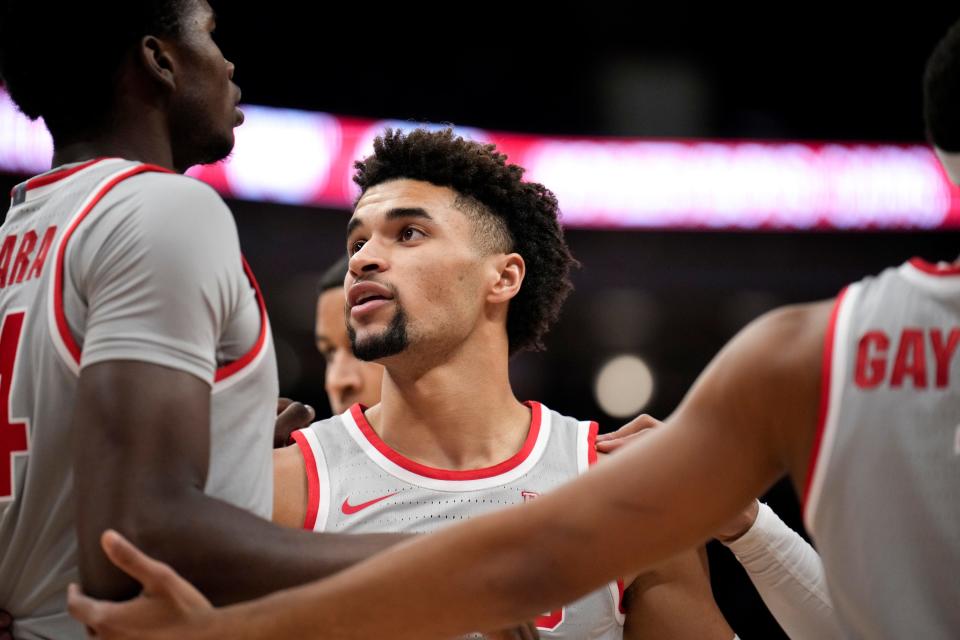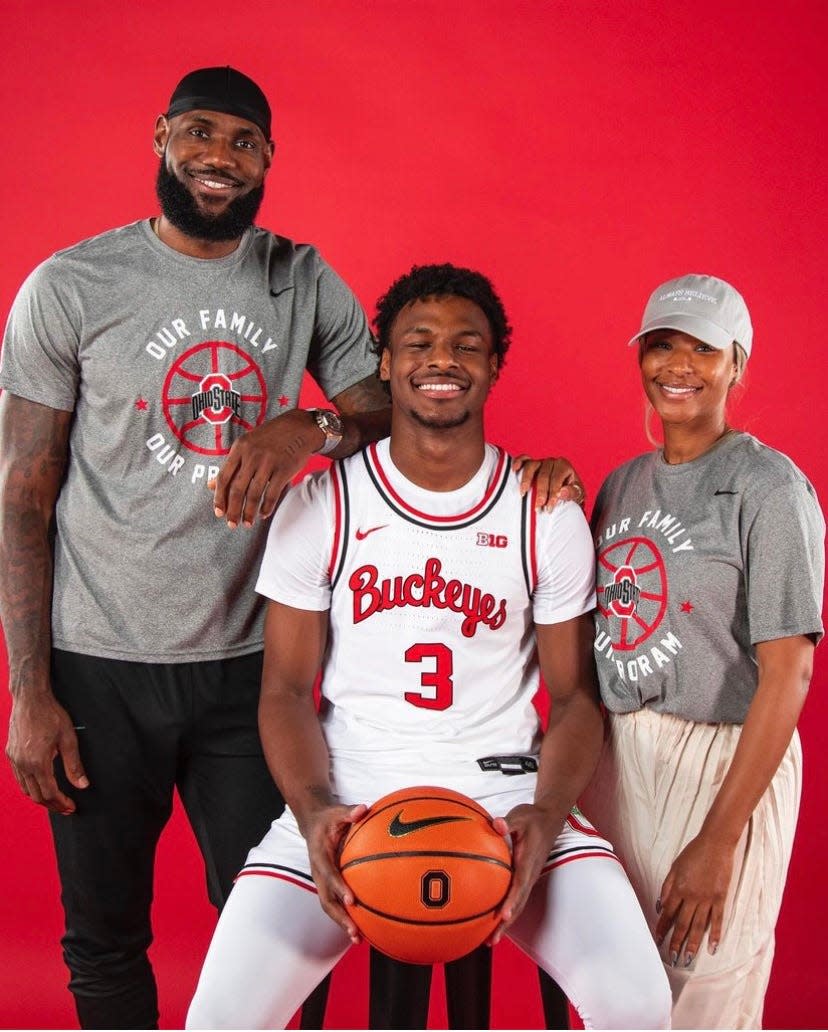As Tanner Holden departs, five thoughts on Ohio State's present and future
A month and a half after the season ended, Ohio State’s roster for 2023-24 is nearing its final form. Wednesday afternoon, a widely anticipated domino fell into place when Tanner Holden, a transfer from Wright State, opted to enter the transfer portal after one season as a lightly used reserve for the Buckeyes.
Holden is the second player to enter the portal from the 2022-23 roster and is likely the last. He joins Gene Brown III, a wing who averaged 2.2 points and 1.7 rebounds in 77 games during the last three years for the Buckeyes. In their places, Ohio State has added commitments from veteran transfers Jamison Battle, a forward from Minnesota, and Dale Bonner, a guard from Baylor.
One roster decision remains, and it could influence another. Big Ten all-freshman team selection and Ohio State leading scorer Brice Sensabaugh has declared for the NBA draft but retained his collegiate eligibility. Should he decide to return, which is a longshot that grows by the day, the Buckeyes would still have a roster spot for him as of Holden’s announcement.
Here are five thoughts on Ohio State after Holden’s decision.
Ohio State Buckeyes: Join the Ohio State Sports Insider text group with Bill Rabinowitz, Joey Kaufman Adam Jardy
Why didn’t it work for Tanner Holden and Ohio State?
When coach Chris Holtmann spoke with reporters during the preseason, he was effusive in his belief that the development of four freshmen – Roddy Gayle, Felix Okpara, Bruce Thornton and Sensabaugh – would have a significant impact on the season. But as their growth would likely increase during the back half of the season, Holtmann also included Holden into that equation.
“A good thing for us I’m excited about is we get him for two years, and I think we could see his second year be significantly better than his first but I still think he’s definitely going to help us this year,” Holtmann said at Big Ten media day. “I’ve always sensed that guys in his position … you really see them come on, the back half of that first year, kind of like a freshman.”
Instead, it was the opposite for Holden, who fell out of the rotation even as Ohio State’s losses piled up and the team missed the NCAA Tournament for the first time since 2017. After playing double-digit minutes in all but one of the first 19 games of the year, Holden was a healthy, unused substitute in eight of 11 games from Feb. 5 through March 10. He hit the buzzer-beating 3-pointer to beat Rutgers at Value City Arena on Dec. 8, and after playing 16:37 in a slump-busting win against Iowa on Jan. 21 he was averaging 4.6 points on 49.2% shooting (29 for 59) while playing 16.3 minutes per game.

In Ohio State’s final 16 games, Holden attempted 10 shots and made four of them. He scored nine points and totaled 45:56 of playing time. Ohio State stumbled through a nine-game losing streak during that period.
So even as the Buckeyes were losing at a rate not seen in decades, Holden couldn’t get on the floor. It was surprising given that, albeit at a lower level, Holden had never missed a game in three seasons for Wright State and averaged 16.1 points per game. Holden was not made available for postgame interviews as the season progressed, and although he saw some action in the Big Ten Tournament he did not speak with reporters in Chicago. In a change from previous policies, the Big Ten closed locker rooms for postgame access.
“Everyone who plays any sport wants to get the glory of being the scorer,” Holden said Jan. 23, the final time he would meet with reporters. “If Roddy needs something from me I want to be that guy he can look to. I want to be the person people can count on. I think that’s definitely a huge thing in basketball. Defense is not the fun part to do. No one wants to play defense the whole time. Being able to sacrifice for the greater good of the team to win, we want to do anything we can to win.”
Holtmann was tight-lipped about Holden as the year progressed. He was asked about the Wright State transfer before going to Chicago for the Big Ten Tournament.
“Tanner’s had a good approach,” the coach said March 6. “Been working in practice, working to get better on some of those areas that we’ve challenged him with. The rotation, I like where it’s at, but Tanner’s done a really good job in practice.”
Glean what you will from that answer, but it was clear as the season progressed that Holden had played his way to the wrong side of the rotation.
How much does this impact Ohio State next year?
It depends on how much stock you put into Holtmann’s preseason comments. On a team that is losing Justice Sueing and likely Sensabaugh, there is opportunity for playing time on the wing. Incoming first-year forwards Scotty Middleton and Devin Royal will figure prominently into the equation, as will Minnesota transfer Jamison Battle, but there is a level of Holden’s game that never materialized while at Ohio State.
Had Holden returned, he was likely looking at a role of 15-20 minutes per game like he had fulfilled for roughly the first 20 games this season. Without him, those minutes will likely primarily go to Middleton as a small forward and a multitude of three-guard lineups.
Ohio State basketball: Native Minnesotan Taison Chatman ready to make impact at Ohio State
Worth noting: In three years at Wright State, Holden had played four Tier A or Tier B games according to KenPom.com. The cutoffs for those classifications are top-50 and top-100 opponents, respectively, adjusted for location. It took Holden seven games to hit that total while at Ohio State.
It’s a steep learning curve. Maybe year two would’ve seen more production from Holden. Maybe not.
What is Ohio State’s scholarship situation?
When Bonner committed to Ohio State, the Shaker Heights, Ohio, native gave the Buckeyes an experienced guard who could help fill out some of those aforementioned three-guard lineups this season. It also meant that, should Holden and Sensabaugh both want to return to Ohio State for 2023-24, the Buckeyes would have 14 players for 13 scholarships.
Holden entering the portal squares that number and gives Ohio State 13 players, including Sensabaugh, occupying roster spots for the upcoming season. Here’s the rundown:
Sixth year – BonnerFifth year - BattleFourth year – Zed KeyThird year – Kalen EtzlerSecond year – Bowen Hardman, Gayle, Okpara, Thornton, Sensabaugh*First year – Taison Chatman, Austin Parks, Middleton, Royal
Sensabaugh is unlikely to return, although he still has that option. If he doesn’t, Ohio State could still add another piece via the portal or keep walk-on center Owen Spencer on scholarship. If the Buckeyes do bring in another piece, look for them to simply add the best available player who fits into the picture rather than targeting a specific position of need. Ohio State could keep a tighter rotation this season, one that right now would be filled out by Bonner, Battle, Key, Gayle, Okpara, Thornton, Chatman, Middleton and Royal all playing meaningful minutes.
Does this mean Bronny James is coming to Ohio State?
This decision has nothing to do with James, who has been linked with Ohio State during his recruitment but has said nothing publicly about where he might be leaning or what he’s looking for in a school.

A four-star prospect in the 247Sports.com composite, James is rated as the No. 36 national recruit – five spots behind Chatman and slightly ahead of where Gayle (No. 50) and Thornton (54) were in last year’s rankings. All three guards will play significant minutes in Ohio State’s backcourt this season. In order to support them, the Buckeyes added Bonner – a solid-if-unspectacular player who will be counted on to provide leadership and, most importantly, experience at such a youthful position.
The fit between Ohio State and James would make little sense for either party. With an eye on being a one-and-done player, James would not be guaranteed the number of minutes needed to produce enough to prepare himself for the NBA so quickly. And for Ohio State, while adding the son of LeBron James would certainly increase the team’s exposure, he’s not an obvious upgrade over any of the current younger guards currently on the roster.
So, again, Holden’s departure does not signify that the Buckeyes are clearing space to add James to their 2023 class.
What’s next for Tanner Holden?
This situation exposes an issue within the new era of college basketball. Holden transferred to Ohio State after Wright State with two years of eligibility thanks to the extra year given by the NCAA to all athletes who participated in the 2020-21 season played amid the COVID-19 pandemic. He also was able to play immediately because of the blanked one-time transfer waiver afforded to all players regardless of situation.
Second-time transfers aren’t nearly as painless, however. Holden has not yet graduated, preventing him from gaining immediate eligibility as a graduate transfer unless he were to transfer back to Wright State for his final season. Or, should he opt to find a new school, Holden would have to appeal for a waiver for immediate eligibility from the NCAA.
Ohio State Buckeyes: Results aside, 'Buckeye Boys' enjoy Ohio State's tough season together
It’s not clear how easy that latter option might be. Although the rules state that second-time transfers should be required to sit out a year before playing, there are significant doubts as to how strongly the NCAA could – or would – try to enforce that. A move back to Wright State, however, would not require a waiver and would likely allow him to both earn a degree and finish his career in the 2023-24 season.
Get more Ohio State basketball news by listening to our podcasts
This article originally appeared on The Columbus Dispatch: Tanner Holden transfers: here are 5 things to know about Ohio State
